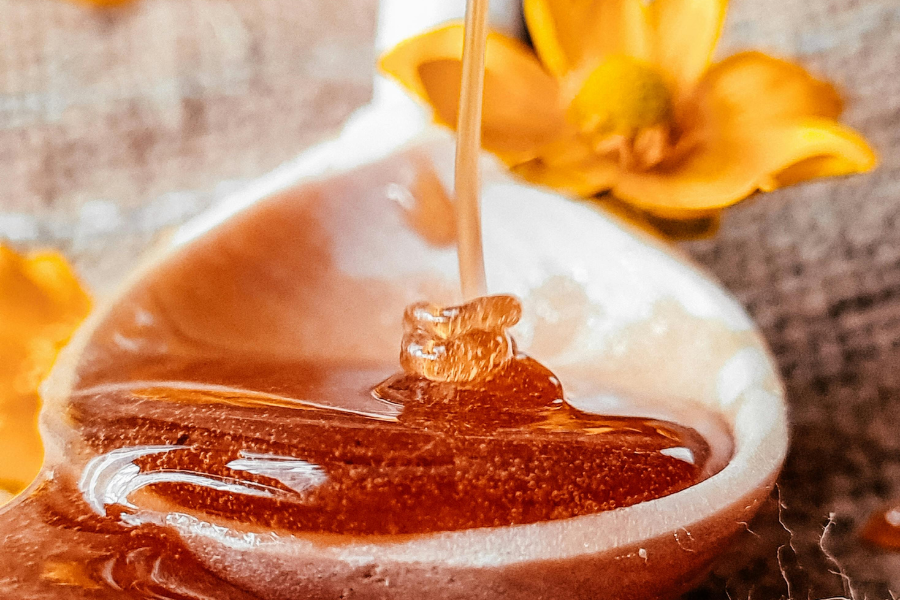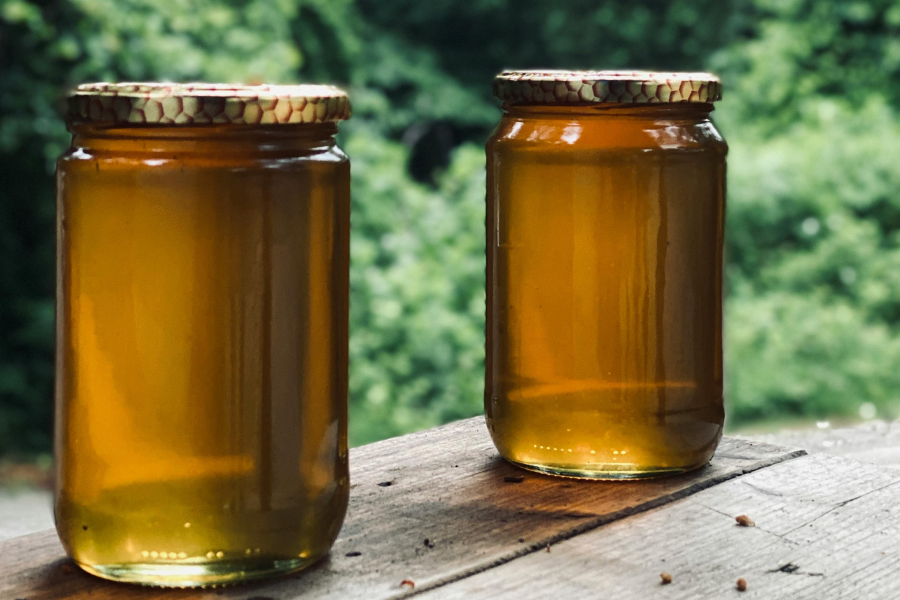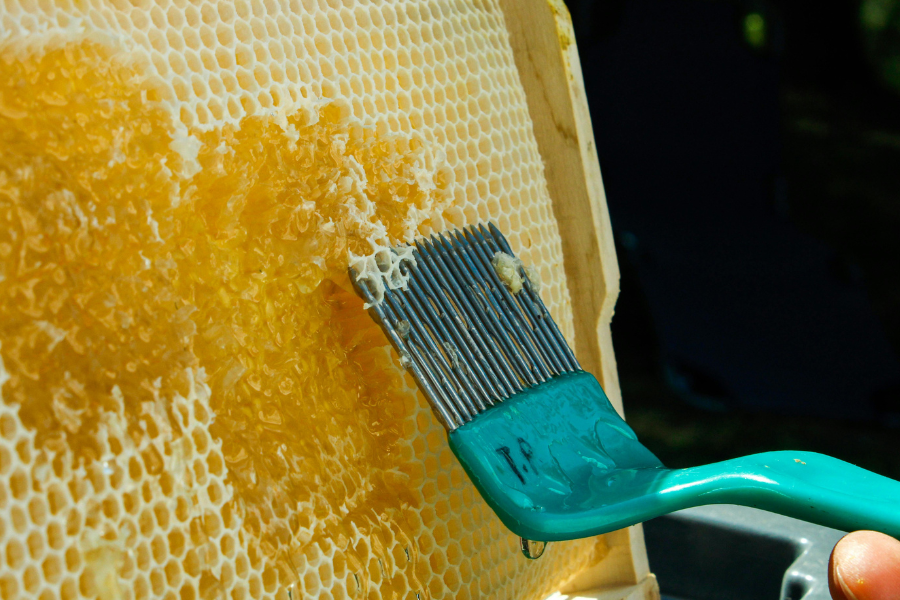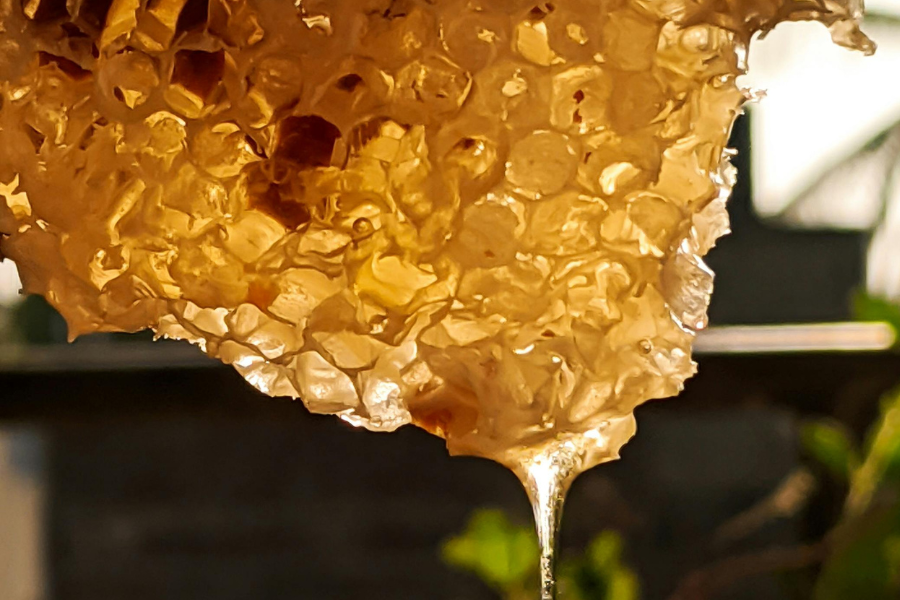Table of Contents
Introduction
Turning raw nectar into the golden honey we love is an art as much as it is a process. Whether you’re a seasoned beekeeper or just starting out, knowing the steps involved is key to producing top-quality honey. From choosing the right tools for extraction to sealing it perfectly in bottles, here’s a closer look at how honey goes from hive to table.
7 Different Stages Of Honey Processing
1. Harvesting the Honeycomb
Timing the Harvest:
- Harvest honey when the honeycomb cells are fully capped.
- Capped cells indicate the honey has reached the ideal moisture content (below 18%).
- This ensures high-quality honey during the processing stage.
Removing Frames:
- Carefully extract the frames from the hive.
- Minimize disturbances to the bees.
- Protect the honeycomb structure to ensure it can be used for future harvests.
2. Uncapping the Honeycomb
- Manual Uncapping: Use uncapping tools like uncapping knives or forks to remove the wax caps from each honeycomb cell.
- Electric Uncapping: For larger operations, using electric uncapping knives can make the process faster and more efficient.
3. Extracting the Honey
- Manual Extractors: For small-scale beekeepers, a honey extractor allows you to manually spin the frames and extract the honey.
- Electric Extractors: On a larger scale, electric honey extractors automate the process, making it quicker and more efficient, especially when dealing with high volumes of honey.
4. Filtering the Honey
- Straining: To purify honey, use fine mesh filters to remove wax, debris, and other impurities that may be present after the extraction.
- Settling: Allow the honey to sit undisturbed in settling tanks for several hours so that air bubbles and remaining impurities rise to the surface.
5. Bottling and Packaging
- Storage Containers: Store honey in clean, food-grade containers to prevent contamination.
- Labeling: Ensure that jars are labeled with production date and other relevant details like origin or variety, making them ideal for commercial honey production.
6. Pasteurization (Optional)
- Purpose: Pasteurizing honey involves heating it to 55°C to liquefy it for easier handling and longer shelf life.
- Considerations: While pasteurization extends shelf life, it may reduce some of honey’s beneficial enzymes, so it’s a personal choice based on whether you want to retain raw honey’s full nutritional benefits.
7. Storage
- Temperature: Keep honey in a cool, dry place to preserve its quality.
- Humidity: Prevent moisture from entering the honey, as high humidity can lead to fermentation, which affects the honey’s taste and consistency.
Essential Equipment for Honey Processing
If you want to produce high-quality honey efficiently, having the right equipment is a must. Here’s a rundown of the essential tools every beekeeper needs:
- Honey Extractors: These are used to get the honey out of the comb. If you’re working with small batches, a manual extractor is fine. For larger operations, an electric one can speed things up.
- Uncapping Tools: You’ll need uncapping knives, forks, or even an electric uncapping machine to remove the wax from the honeycomb cells.
- Honey Filters: After extracting the honey, fine mesh filters help strain out any wax or impurities, leaving you with pure honey.
- Bottling Equipment: For packaging, you’ll need clean, food-grade jars and containers. Don’t forget labeling tools if you’re selling your honey!
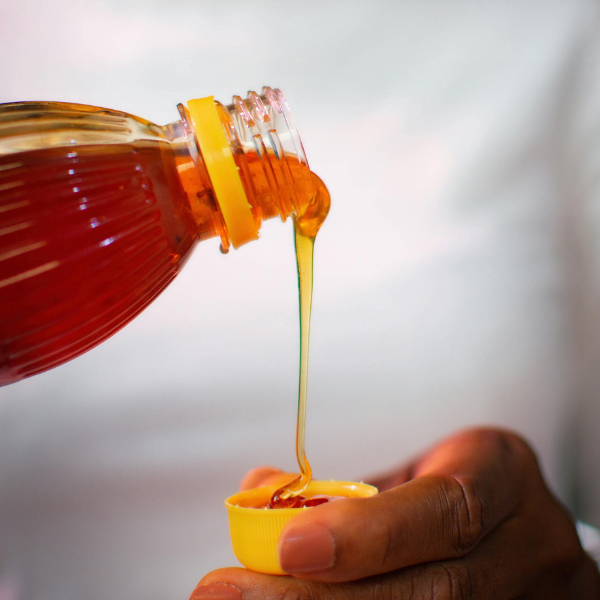
Optimizing Honey Processing: Innovative Solutions for Efficiency, Quality, and Profitability
- Boost Honey Yield with the Right Equipment
Investing in good honey extraction gear, like automated extractors, makes a big difference in how quickly and efficiently you can get the honey out. Electric extractors, in particular, are great for commercial beekeepers. They speed up the process, letting you handle more honey with less physical work, which means higher yields without sacrificing quality. - Increase Profits with Quality Bottling
How you package your honey can have a big impact on how well it sells. Using commercial processing and packaging equipment ensures your honey is clean and consistently packaged, making it stand out in stores. If you’re targeting premium markets, investing in customized jars and high-end labels can create a product that attracts health-conscious buyers. - Reduce Waste with Proper Filtering
Proper honey filtering removes impurities like wax, pollen, and propolis, leaving you with pure, clean honey. Using fine mesh filters and settling tanks ensures minimal waste and higher-quality honey, which is crucial in a competitive market. - Keep Raw Honey’s Nutritional Value with Cold Pressing
If you’re aiming to produce raw honey, cold-pressing is a great way to preserve its natural enzymes, antioxidants, and vitamins. While pasteurized honey lasts longer, cold-pressed honey appeals to health-conscious customers who want a more natural, nutrient-rich product. - Avoid Crystallization with Proper Storage
Crystallization is a common issue in honey storage, but you can avoid it by keeping honey in cool, dry places and using airtight containers. This helps maintain a smooth texture and ensures your honey stays fresh longer, which is key for beekeepers selling honey commercially. - Honey Coffee for Unique Products
For commercial beekeepers looking for something different, honey coffee is an innovative idea. This process involves drying coffee beans with honey, giving them a unique flavor that can be marketed as a specialty product. It’s a great way to tap into both the coffee and honey markets, creating a crossover product that appeals to consumers. - Upgrade Your Equipment for Large-Scale Operations
For large-scale honey production, advanced extraction equipment like Maxant processing gear can help you manage big volumes without losing quality. Automation makes things faster, reduces labor costs, and keeps production consistent, giving your honey a competitive edge. - Ensure Top Quality Honey
Implementing quality control during processing is key to making sure your honey meets industry standards. Regular testing for things like moisture content and taste ensures your honey is always consistent and ready to hit the market. - Diversify Honey for Different Markets
Honey isn’t just for sweetening; it’s also used in skincare, medicine, and wellness products. By offering variations like creamed or flavored honey, you can attract different types of customers. Diversifying your honey products is a great way to increase profitability, especially if you’re targeting health-conscious or eco-minded buyers. - Simplify Production with Automation
Automating parts of the honey processing, like uncapping and bottling, can save you a lot of time and money. Many modern extraction machines have automated features that increase speed and accuracy. For commercial beekeepers, automation is a great way to keep up with demand while maintaining quality.
Ensuring Optimal Honey Quality Through Proper Extraction and Storage
- Advanced Honey Extraction: Use centrifugal extractors or honey extracting equipment to minimize comb damage and maximize honey yield.
- Manual Extractors: Smaller-scale beekeepers can rely on manual honey extractor tools for better control over honey quality.
- Filtering and Avoiding Over-Heating: Filter honey to remove impurities, but avoid pasteurizing it, as heating reduces its nutritional value.
- Proper Storage: Store honey in air-tight containers to maintain its freshness and prevent moisture absorption that can lead to fermentation.

Protecting Honey Purity and Avoiding Common Pitfalls in Honey Processing
- Cold Press Honey: Use cold pressing methods to retain honey’s natural enzymes, antioxidants, and vitamins for a higher-quality product.
- Minimal Interference: Ensure minimal processing to preserve honey’s natural state for premium-quality products.
- Honey Coffee Process: Consider the honey process coffee method for creating unique flavors, offering diversification opportunities for beekeepers.
- Glass Containers: Store honey in glass containers instead of plastic to preserve its taste and texture.
Innovative Approaches to Enhance Honey Production and Quality
- Vacuum Honey Extractors: Using vacuum extractors helps reduce air exposure during honey extraction, which can help preserve the natural flavor and color of the honey.
- Automated Bottling Systems: Implementing automated bottling systems speeds up the honey processing while keeping everything clean and precise, making the process more efficient.
- Honeydew Honey: Offering honeydew honey from forest bees can set your honey apart. It has a unique taste that will appeal to consumers looking for something different.
- Beekeeping Drones: Beekeeping drones can help monitor your hives in real-time, ensuring the bees have the best conditions for producing high-quality honey.
- Beeswax Filtration Systems: Using beeswax filtration systems helps remove impurities from honey, ensuring a cleaner product while keeping the honey’s quality intact.
Maximizing Honey Quality with Advanced Processing and Storage Techniques
- Use honey processing equipment that minimizes waste and preserves the comb.
- Opt for honey extractor tools with adjustable speeds to optimize extraction.
- Implement innovative filtering techniques in honey processing plants to remove wax and debris.
- Store honey at cooler temperatures, ideally in dark glass jars, to protect it from light and heat.
- Prevent crystal formation and preserve natural flavor with proper storage methods.
- Invest in commercial honey extraction equipment for consistent quality in larger operations.
Key Insights on Honey Production, Purity, and Storage
- Nectar Collection: Bees gather nectar from flowers to begin the honey-making process.
- Honey Formation: Enzymes in the hive convert nectar into honey through evaporation and enzymatic action.
- Capping: When fully ripened, bees seal the honeycomb with wax caps.
- Extraction: Uncapping and using honey extraction equipment to retrieve honey from the comb.
- Filtering and Bottling: The honey is filtered to remove debris before being bottled.
- Does Honey Expire?: Pure honey doesn’t expire, but it can crystallize over time.
- Bacteria Growth in Honey: Due to its natural acidity and low moisture content, honey is inhospitable to bacteria.
- Color of Honey: Honey’s color can range from golden to amber, depending on the nectar source.
- Sugar Content: Honey contains natural sugars like fructose and glucose.
- Purity Check: Real honey is thicker and flows more slowly than fake honey.
- Crystallization: Crystallization is a natural process that doesn’t affect honey’s quality.
- Storage: Store honey in a cool, dry place to preserve its flavor and quality.
- Popular Honey Brands: Brands like Patanjali and Dabur offer pure honey, but verify authenticity through certifications.
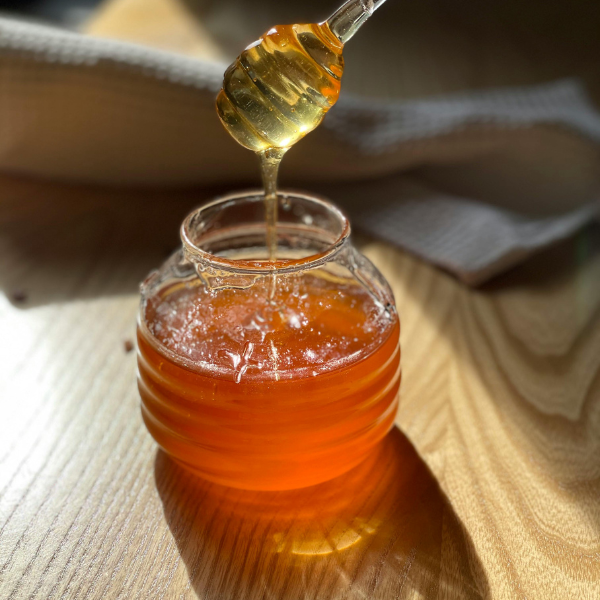
Revolutionary Features of Modern Honey Machinery
- Automated Filtering: Removes impurities while preserving honey’s natural enzymes.
- Temperature Control: Prevents overheating to protect honey’s flavor and nutrients.
- Anti-Drip Valves: Ensures mess-free and efficient bottling.
- Humidity Maintenance: Specialized tanks keep honey fresh with optimal moisture levels.
- Eco-Friendly Materials: Supports sustainable beekeeping practices for environmentally conscious users.
Conclusion
Mastering the steps of honey processing—from carefully extracting honey with extractors to bottling it—ensures you can produce top-quality honey. By using the right equipment and techniques, beekeepers can get the best results while also keeping their hives healthy. Whether you’re processing honey at home or on a larger scale, the right tools, timing, and methods will help you create pure, delicious honey that really stands out.
Frequently Asked Questions (FAQs)
What is the best time to harvest honey?
Harvest honey when the majority of frames are capped and the moisture content is low (below 18%). This is the perfect time for honey extraction.
How can I prevent crystallization in honey?
Store honey at a temperature of around 18°C and in an airtight container. Moisture can cause honey to crystallize, so make sure it stays sealed properly.
Is pasteurization necessary for honey?
No, pasteurization is optional. While it can help extend honey’s shelf life, pasteurization reduces its enzyme content and beneficial properties. Raw honey, however, retains more nutritional benefits.
How do I clean honey extraction equipment?
Clean your honey extractor and all other honey extracting tools right after use with warm water and mild soap. Avoid using harsh chemicals that could leave residues.
How is honey processed into honey coffee?
Honey coffee processing refers to a unique method of coffee bean processing where the beans are dried with honey. This creates a sweeter, more complex flavor profile. Honey processed coffee beans have a distinct taste from traditionally processed beans.

